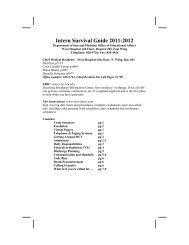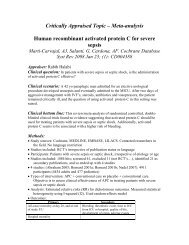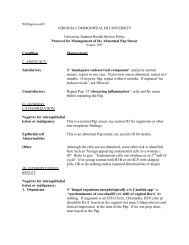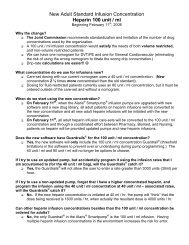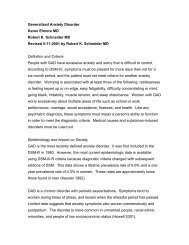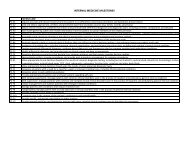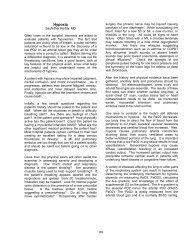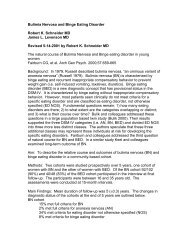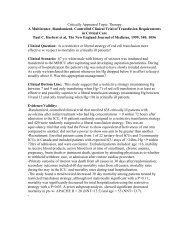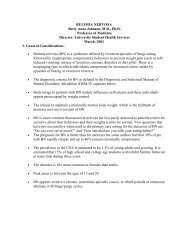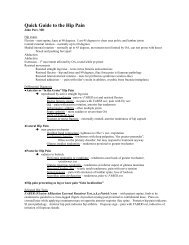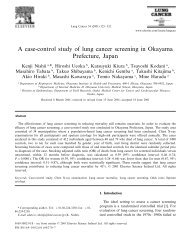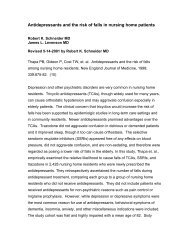Necrotizing Fasciitis
Necrotizing Fasciitis
Necrotizing Fasciitis
Create successful ePaper yourself
Turn your PDF publications into a flip-book with our unique Google optimized e-Paper software.
<strong>Necrotizing</strong> <strong>Fasciitis</strong><br />
Morning report—July 18 2005<br />
Zach Shook, M.D.<br />
1. Epidemiolgy:<br />
• Increased incidence in diabetics, alcoholics, immunosuppressed pts, IV<br />
drug users, pts with PVD.<br />
• Can also occur in YOUNG, HEALTHY ADULTS<br />
2. Etiology:<br />
• Most common in abdominal wall, extremities and perineum<br />
• Entry of pathogen via skin breakdown>>hematogenous (pharyngitis)<br />
• Male (female) genitalia (perineum): Fournier’s Gangrene<br />
3. Clinical presentation and pathophysiology:<br />
• Early Nec Fasc: extremely painful: “PAIN OUT OF PROPORTION TO<br />
EXAM”<br />
• Skin changes: celluliticsmooth, shiny, tensely swollendarkening,<br />
dusky with bullaenecrosis of superficial fascia/fat with “dishwater pus”<br />
• Untreated, disease almost universally fatal<br />
4. Microbiology:<br />
• Type 1: polymicrobial, non-group A strep aerobe + anaerobe or<br />
facultative anaerobe, often enterobacteriaceae.<br />
• Type 2: (classic) group A, beta-hemolytic streptococcus +/- staph.<br />
• “Type 3:” Vibrio: wound caused by fish or exposed to sea water…<br />
• Never anaerobes alone, remember anaerobes often present, not cultured.<br />
• No difference in morbidity and mortality between species.<br />
• Soft-tissue gas formation: anaerobic/mixed infections<br />
• Tissue damage from bacterial toxins and endogenous cytokines<br />
• new strains of more virulent group A strep…maybe not.<br />
Gram + aerobes:<br />
Group A, beta-hemolytic strep, Group B strep, Enterococci, Coag neg staph, Staph aureus, Bacillus<br />
Gram – aerobes:<br />
E. coli, Pseudomonas, Enterobacter, Klebsiella, Proteus, Serratia, Acinetobacter, Citrobacter, Pasturella<br />
Anaerobes:<br />
Bacteroides, Clostridium, Peptostreptococcus<br />
Marine sps:<br />
Vibrio (vulnificus, parahemolyticus, damsela, alginolyticus)<br />
Fungi:<br />
Candida, Aspergillus, Rhizopus<br />
5. Diagnosis:<br />
• “Owing to the paucity of skin findings early in the disease, diagnosis is<br />
often extremely difficult and relies on a high clinical index of suspicion.<br />
• Signs: severe local pain, fever, signs of systemic disease<br />
• Dx by lack of resistance of normally adherent fascia to blunt dissection or<br />
full thickness skin biopsy<br />
• Radiology: gas on plain film (more sensitive than physical exam), CT,<br />
MRI as gold standard--cost, time, clinical availability
6. Treatment<br />
• SURGICAL!!!—early surgical intervention is critical, proven to lower<br />
mortality<br />
• Surgical goal: perform definitive surgery the first resection—wide, wide<br />
margins. (survival documented with up to 45% skin surface area resected)<br />
• Need frequent exams of surgical site post-op as many pts require multiple<br />
debridements<br />
• MEDICALl—broad spectrum coverage of aerobes (gram + and -) and<br />
anaerobes.<br />
• If Group A strep: high dose pcn and clinda.<br />
• SUPPORTIVE CARE<br />
• Hyperbaric Oxygen—retrospective studies with mortality benefit<br />
7. Mortality:<br />
• From 29%--76%, largely dependent on time-course, when treatment<br />
begun…<br />
Reference:<br />
Green, RJ. <strong>Necrotizing</strong> <strong>Fasciitis</strong>. Chest, 1996; 110; 219-229<br />
www. chestjournal.org.



